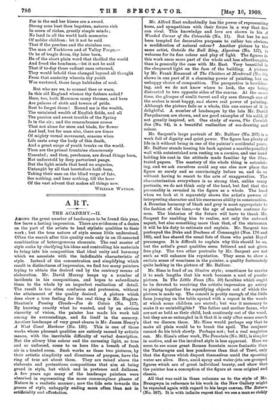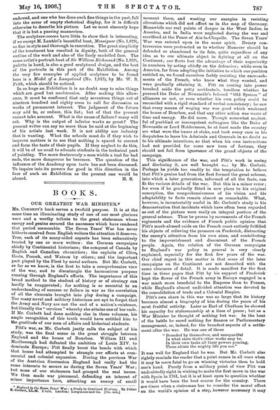ART.
THE ACADEMY.—II.
AMONG the great number of landscapes to be found this year, few leave a lasting impression. There are evidences of a desire on the part of the artists to lend stylistic qualities to their work ; but the true nature of style seems little understood. Often the search after this quality ends only in an ill-assorted combination of heterogeneous elements. The real master of style seeks by clarifying his ideas and controlling his materials to bring into his composition that ideal unity and harmony which we associate with the indefinable characteristic of style. Instead of the concentration and simplifying which result in distinctness of impression, we find too many painters trying to obtain the desired end by the contrary means of elaboration. Mr. David Murray heaps up a number of incidents in his compositions, and hopes to subordinate them to the whole by an imperfect realisation of detail. The result is too often confusion and pretension, without the attainment of the quality desired. A picture which does show a true feeling for the real thing is Mr. Hughes- Stanton's Passing Clouds—Pas de Calais (No. 117). By knowing exactly what he wanted, and by an obvious sincerity of vision, the painter has made his work tell among its surroundings, and fix itself in the memory. Another landscape of very great charm is Mr. James Henry's A West Coast Harbour (No. 130). This is one of those works whose pleasant qualities are entirely caused by artistic means, with the inevitable difficulty of verbal description. But the silvery blue colour and the caressing light, so true and so unforced, come to us here like a breath of fresh air in a heated room. Such works as these two pictures, by their artistic simplicity and directness of purpose, have the ring of true art about them. They are raised above the elaborate and pretentious compositions that aim at being grand in style, but which end in pretence and dullness. A few years ago many of the landscape painters were absorbed in representing the more commonplace phases of Nature in a realistic manner ; now the tide sets towards the graces of style, unhappily ending more often than not in artificiality and affectation. Mr. Alfred East undoubtedly has the power of representing trees, and sympathises with their forms in a way that few can rival. This knowledge and love are shown in his A Wooded Corner of the Cotswolds (No. 11). But has he not been tempted for decorative purposes to rather too obvious a modification of natural colour P Another picture by the same artist, Outside the Bull Ring, Algeciras (No. 157), is welcome for its fine colour and play of light. The figures in this work seem more part of the whole and less afterthoughts than is generally the case with Mr. East. Very beautiful is the chequered light on the face of the building. A picture by Mr. Frank Emanuel of The Cloisters at Montreuil (No. (36) shows in one part of it a charming power of painting, but an unhappy choice of composition. The perspective is bewilder- ing, and we do not know where to look, the eye being distracted to two opposite sides of the canvas. At the same time, the glimpse of sunlit turret and sky seen through one of the arches is most happy, and shows real power of painting. Although the picture fails as a whole, this one corner of it is delightful. A number of landscapes by the late Mr. David Farquharson are shown, and are good examples of his solid, if not greatly inspired, art. One study of waves, The Cornish, Sea (No. 94), is a beautiful realisation of sea-drawing and colour.
Mr. Sargent's large portrait of Mr. Balfour (No. 207) is a work full of dignity and quiet power. The figure has plenty of life in it without being in one of the painter's accidental poses. Mr. Balfour stands leaning his back against a marble-panelled wall with outstretched arm resting on a cornice, and one hand holding his coat in the attitude made familiar by the illus- trated papers. The mastery of the whole thing is astonish- ing, and we ask ourselves could any one else uow place the figure so surely and so convincingly before us, and do so without having to resort to the arts of exaggeration. The characterisation everywhere is so strong that, unlike many portraits, we do not think only of the head, but feel that the personality is revealed in the figure as a whole. The head when we look at it separately shows the artist's powers of interpreting character and his enormous ability in construction. A Brescian harmony of black and grey is most appropriate to the fashion of the time,—to the age of sombre costume for men. The historian of the future will have to thank Mr. Sargent for enabling him to realise, not only the outward aspect, but also something more than that, of the statesman it will be his duty to estimate and explain. Mr. Sargent has portrayed the Duke and Duchess of Connaught (Nos. 176 and 183), and has shared the usual fate of those who paint Royal personages. It is difficult to explain why this should be so, but the artist's great qualities seem fettered and not given free play. The two other portraits by Mr. Sargent are not such as will enhance his reputation. They seem to show a certain sense of weariness in the painter, a quality fortunately quite lacking in the picture of Mr. Balfour.
Mr. Sims is fond of an illusive style ; sometimes he carries it to such lengths that his work becomes a sort of puzzle- picture. In The Little Faun (No. 50) faculties which ought to be devoted to receiving the artistic impression go astray in piecing together the mystifying objects out of which the picture is made up. The conceit is pretty enough of the little faun jumping on the table spread with a repast in the woods at which some children are seated ; but was it necessary to make it so unintelligible P The father and mother fauns, who are not so bold as their child, look cautiously out of the wood, but they are so entangled in it that it is only after some search that we discern them. Mr. Sims would perhaps say that to make all plain would be to break the spell. The conjurer cannot do his trick slowly. Perhaps not ; but a real magician can. Mr. Sims's other work, The Fountain (No. 361), is simpler in motive, and so the involved style is less apparent. Here we seem to see some great Roman fountain more fantastic than the Tartarugue and less ponderous than that of Trevi, only that the figures which disport themselves amid the spouting water are alive. Here, amid spray and water-jets am grouped figures which are of great individual beauty, and show that the painter has a conception of the figure at once original and classic.
All that was said in these columns as to the style of Mr. Brangwyn in reference to his work in the New Gallery might be repeated again with regard to his large canvas, The Return (No. 267). It is with infinite regret that we see a man so richly
endowed, and one who has done such fine things in the past, fall into the error of empty rhetorical display, for it is difficult otherwise to describe his picture. Let us most sincerely hope that it is but a passing mannerism.
The sculpture-rooms have little to show that is interesting, if we except M. Lanteri's beautiful bust, Monsignor (No. 1,879), so fine in style and thorough in execution. The great simplicity of the treatment has resulted in dignity, both of the general outline of the work and also of the finely modelled face. The same artist's portrait-bust of Sir William Richmond (No. 1,859), palette in hand, is also a good sculptural design, and the best of the portraits in this part of the Exhibition. Among the very few examples of applied sculpture to be found here is a Model of a Lampsland (No. 1,813), by Mr. W. S. Frith, which should be noticed.
In so huge an Exhibition it is no doubt easy to miss things which are good but unobtrusive. After making this allow- ance, it must be confessed that only seventeen things out of nineteen hundred and eighty seem to call for discussion as works of permanent interest. The judgment of the future may add to, or reduce, this list; but of that the present cannot take account. What is the cause of failure ? many will ask. Why is the output of inferior works so great? The present writer can say no more than he said at the beginning of his artiele last week. It is not ability nor industry that is wanting. What the schools must do if they wish to improve matters is to see that nothing is spared to correct and form the taste of their pupils. If they neglect to do this, it will be of no avail to educate students in the technical part of painting. The more dexterously a man wields a tool for bad ends, the more dangerous he becomes. The question of the influence of the Academy upon taste has not been discussed. To inquire into its powers for good in this direction in the face of such an Exhibition as the present one would be
absurd. H. S.















































 Previous page
Previous page